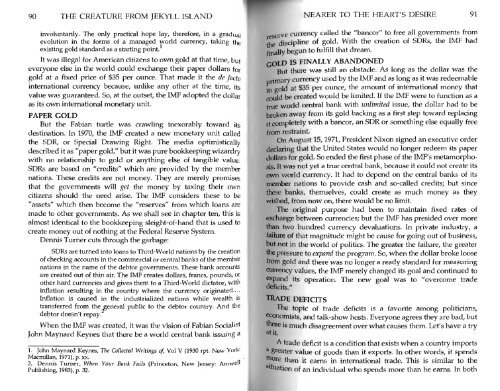You also want an ePaper? Increase the reach of your titles
YUMPU automatically turns print PDFs into web optimized ePapers that Google loves.
90 THE CREATURE FROM JEKYLL ISLAND<br />
involuntarily. The only practical hope lay, therefore, in a gradual<br />
evolution in the forms of a managed world currency, taking the<br />
existing gold standard as a starting point.<br />
It was illegal for American citizens to own gold at that time, but<br />
everyone else in the world could exchange their paper dollars for<br />
gold at a fixed price of $35 per ounce. That made it<br />
international currency because, unlike any other at<br />
the de facto<br />
the time, its<br />
value was guaranteed. So, at the outset, the IMF adopted the dollar<br />
as its own international monetary unit.<br />
PAPER GOLD<br />
But the Fabian turtle was crawling inexorably toward its<br />
destination. In 1970, the IMF created a new monetary unit called<br />
the SDR, or Special Drawing Right. The media optimistically<br />
described it as "paper gold," but it was pure bookkeeping wizardry<br />
with no relationship to gold or anything else of tangible value.<br />
SDRs are based on "credits" which are provided by the member<br />
nations. These credits are not money. They are merely promises<br />
that the governments will get the money by taxing their own<br />
citizens should the need arise. The IMF considers these to be<br />
"assets" which then become the "reserves" from which loans are<br />
made to other governments. As we shall see in chapter ten, this is<br />
almost identical to the bookkeeping sleight-of-hand that is used to<br />
create money out of nothing at the Federal Reserve System.<br />
Dennis Turner cuts through the garbage:<br />
SDRs are turned into loans to Third-World nations by the creation<br />
of checking accounts in the commercial or central banks of the member<br />
nations in the name of the debtor governments. These bank accounts<br />
are created out of thin air. The IMF creates dollars, francs, pounds, or<br />
other hard currencies and gives them to a Third-World dictator, with<br />
inflation<br />
resulting in the country where the currency originated.,..<br />
Inflation is caused in the industrialized nations while wealth is<br />
transferred from the eeneral public to the debtor country. And the<br />
debtor doesn't repay.<br />
When the IMF was created, it was the vision of Fabian Socialist<br />
John Maynard Keynes that there be a world central bank issuing a<br />
1. John Maynard Keynes, The Collected Writings of, Vol V (1930 rpt. New York:<br />
Macmillan, 1971), p. xx.<br />
2. Dennis Turner, When Your Bank Fails (Princeton, New Jersey: Amwell<br />
Publishing, 1983), p. 32.<br />
NEARER TO THE HEART'S DESIRE 91<br />
Seive currency called the "bancor" to free all governments from<br />
the discipline of gold. With the creation of SDRs, the IMF had<br />
begun to fulfill that dream.<br />
finally<br />
GOLD IS FINALLY ABANDONED<br />
But there was still<br />
nrimary<br />
an obstacle. As long as the dollar was the<br />
currency used by the IMF and as long as it was redeemable<br />
in gold at $35 per ounce, the amount of international money that<br />
could be created would be limited. If the IMF were to function as a<br />
true world central bank with unlimited issue, the dollar had to be<br />
broken away from its gold backing as a first step toward replacing<br />
it completely with a bancor, an SDR or something else equally free<br />
from restraint.<br />
On August 15, 1971, President Nixon signed an executive order<br />
declaring that the United States would no longer redeem its paper<br />
dollars for gold. So ended the first phase of the IMF's metamorphosis.<br />
It was not yet a true central bank, because it could not create its<br />
own world currency. It had to depend on the central banks of its<br />
member nations to provide cash and so-called credits; but since<br />
these banks, themselves, could create as much money as they<br />
wished, from now on, there would be no limit.<br />
The original purpose had been to maintain fixed rates of<br />
exchange between currencies; but the IMF has presided over more<br />
than two hundred currency devaluations. In private industry, a<br />
failure of that magnitude might be cause for going out of business,<br />
but not in the world of politics. The greater the failure, the greater<br />
the pressure to expand the program. So, when the dollar broke loose<br />
from gold and there was no longer a ready standard for measuring<br />
currency values, the IMF merely changed its goal and continued to<br />
expand its operation. The new goal was to "overcome trade<br />
deficits."<br />
TRADE DEFICITS<br />
The topic of trade deficits is a favorite among politicians,<br />
economists, and talk-show hosts. Everyone agrees they are bad, but<br />
tt^re is much disagreement over what causes them. Let's have a try<br />
at itȦ<br />
trade deficit is a condition that exists when a country imports<br />
a greater value of goods than it exports. In other words, it spends<br />
aore than it earns in international trade. This is similar to the<br />
^tuation of an individual who spends more than he earns. In both


